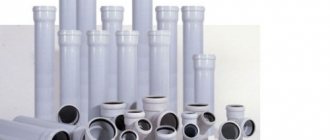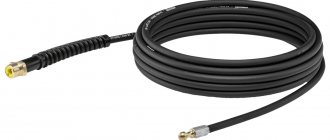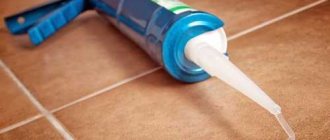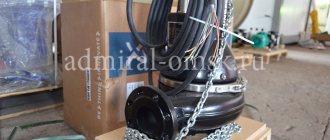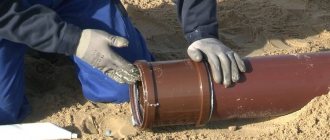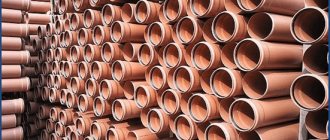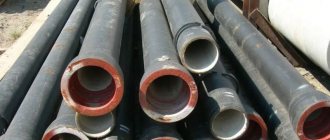What should you do if your sink or bathtub is clogged and the water won’t drain at all? Most often, they try to cope with this problem with the help of a plunger, however, this method is effective only in the case of a shallow blockage. The vacuum created by a manual plunger cannot extend its effect beyond the siphon. A plumber can solve a more serious problem. But not everyone knows about a fairly simple and effective tool that can remove even deep and dense blockages - a plumbing cable. We will tell you what this tool is and how to use a plumbing cable correctly.
Why do blockages occur?
Salt deposits, hard water and sediment deposited on the walls of pipes are the main causes of traffic jams. But there are times when the sewer becomes clogged due to the fault of the user. Remains of preserved food that fall into the toilet, accidentally thrown out garbage, or a floor rag washed out of a bucket can lead to a clog. The waste clogs the sewer pipe and prevents water from draining. Mechanical debris is removed with a spring cable.
The toilet flush can also be blocked by debris that has collected in the shower stall, bathtub, or sink. When washing dishes, kitchen waste can settle in the sewer pipe and accumulate until a blockage forms. Hair from the bathtub and shower also clogs the drain. Operational blockages are eliminated using a rope cable.
There are situations when violations were committed during the installation of the sewer system. Under constant pressure, the weak point is destroyed. In such cases, it will not be possible to eliminate the problem using a cable, since repair or replacement of pipes will be required. Technological blockages are the most complex type of damage.
Traditional methods of dealing with the problem
If there are no chemicals and the blockage is minor, then you can clean the pipes using folk remedies. They are safe not only for human health, but also for pipes.
Boiling water and salt
A solution of hot water and salt removes small blockages. But this method is not suitable for plastic pipes, since the maximum temperature they can withstand is 70 degrees. First, salt is poured into the drain hole, and after 20-30 minutes liquid is poured.
Soda and vinegar solution
This method will clear the drain system of fat deposits. 200 g of powder is poured into the hole, after which 200 ml of acetic acid is poured into it.
To improve the effect, soda can be heated in a frying pan until golden brown. For the reaction to be successful, the hole in the sink must be closed. After 15-20 minutes, the pipe should be rinsed with hot water under pressure. This method will only help with relatively recent blockages. Old traffic jams require radical measures.
Soda and salt
Cleaning the drain works like this: first mix the dry ingredients (half a glass each). The composition is poured into the drain hole and left for 10-12 hours. After this, the pipe is washed with hot water.
Lemon juice or acid
Acid crystals are poured into the siphon hole, then it is filled with water and vinegar. An acidic environment is created to clean pipes from limescale. Acid is poured into the pipe in the amount of 100 g, and then 250 ml of boiling water is poured. After 20 minutes, the pipe is washed with boiling water. If lemon juice is used, then it is simply poured into the drain for an hour. Requires 100 ml of liquid.
Alka-3eltzer
This is a medical product that contains citric acid and acetylsalicylic acid. Additionally, it contains soda.
When interacting with water, these components enter into a chemical reaction. To clean the drain, just throw 2-3 tablets of the product into it and plug the hole.
The procedure lasts no more than 20 minutes.
Washing powder
In this case, a granular product is required. 2 scoops of powder are poured into the pipe. Next, boiling water is poured into it for 5 minutes.
Vinegar, soda and chlorine
Before cleaning using the specified components, all liquid is removed from the sink. Soda ash and baking soda (50 g each) are poured into the drain, and after half an hour vinegar and chlorine (150 ml each) are poured into it. The hole must be well sealed, otherwise a pungent odor will appear in the room. After 40 minutes, the drain is washed.
Soda and vinegar for cleaning pipes: 6 ways to clean drains at home Various reasons can cause blockages in pipes. To combat the problem, various store-bought products are used, for example, Mole. However, you can get rid of it using means that can be found in...
Rock salt
You can clean plugs in cast iron pipes using coarse salt. To obtain a reaction, you will additionally need vinegar essence. First, 300 g of salt is poured into the pipe, 2 liters of boiling water is poured, as well as 100 ml of essence. After 30 minutes, the drain is flushed. If necessary, the procedure can be repeated.
Alkali-based preparations
Alkaline products are good at cleaning fat deposits. A popular drug is KEMI in orange granules.
You will have to work with them carefully, as the substance is caustic. To clean a sewer pipe, you need to pour 1 capful of product into the sink and fill it with hot water.
Liquid alkali-based products are more effective at removing clogs.
Caustic soda
Severe blockages can be cleared with caustic soda (caustic soda). The powder in an amount of 2-3 is placed in a metal container and 12 liters of liquid (cold) is poured.
The composition is gently stirred for half an hour
It is important to take precautions so that the composition does not come into contact with the skin or mucous membranes. The powder should completely dissolve
After this, the bucket is placed on the fire so that the mixture warms up to 70 degrees. Half of the cleaning composition is poured into the drain hole and left for 1.5-2 hours. Next, the rest of the substance is introduced into the pipe, then wait again for 2 hours.
After the soda has completed its action, the pipeline is washed with hot water.
Pros and cons of cleaning a toilet with a plumbing cable
When using a plumbing cable when a toilet is clogged, advantages and disadvantages are revealed, like with any tool.
Experts include the following advantages:
- compactness;
- the ability to launch it into a pipe over long distances;
- ease of use;
- affordable price.
The cable will be found in the house of a practical owner. The tool copes with traffic jams of any complexity. Its use is possible even without the help of a specialist.
Tension rope
The tension cable for cleaning sewer pipes can be spring-screw or rope, and is used more often than other devices. The tension cable for cleaning has the following features among similar equipment.
- Easy to use tool and high efficiency.
- If you compare the tension tool with other types, it is distinguished by its lowest cost.
- Possible installation of any attachment supplied with the main tool on the tension cable.
Types of cables for cleaning the toilet
Automatic and mechanical devices are equipped with attachments to remove dirt. You can break through a clog in the toilet with a cable without the help of a specialist. The tool pushes and pulls out debris using hooks.
There are several types of toilet cleaning tools:
- cable;
- flexible;
- spring;
- tension;
- electric.
A variety of models of cables and attachments for them greatly facilitates the work of removing the valve in the toilet. Attention!
In order not to compact the plug deeply and cause even more damage, experts recommend immersing the cable very carefully, changing the nozzles if necessary. The diameter of the rope rod is 6 mm. The tool is made of galvanized steel. It is usually used in an apartment. The cable length is up to 5 m. It is characterized by high strength and flexibility. The device is capable of clearing operational blockages in the toilet. A split metal tube is wound around the core, allowing it to pick up cork particles and pull them out.
A flexible hose copes more conveniently and effectively with mechanical plugs. The diameter of the cable is 25 mm, the permissible length is up to 50 m, a spiral is attached to the steel core, which allows you to pull out debris. Metal tape is a type of flexible rod. The kit includes tips and a handle.
Spring cable length up to 6 m, wire diameter 9 mm. The tool is based on a hollow steel spring structure. It is convenient to immerse it in the sewer system. Refers to simple household appliances.
A flexible tension cable has a shaft wrapped in spring wire. As the handle turns, the rod becomes tense and rigid. The tool belongs to professional devices. Deals with complex mechanical toilet blockages. Stored in a special drum.
The electric cable is a compact installation. Allows you to clean large diameter pipes. The device is equipped with a pistol-type tip and handle. The wire is wound on a drum.
Nozzles and their purpose
The solution to the problem of how to properly clean a sewer depends to a large extent on the type of through-flow nozzles used.
Ridgid produces one of the widest ranges of feed-through units for its cleaning machines. Devices for similar purposes are often used in manual and electric cables.
If we consider all the models of nozzles, the following groups can be distinguished among them:
Spiral. They have different shapes and purposes. Direct ones are used to remove textile materials stuck in the pipeline, destroy plugs, and take samples of blockages to determine the type of nozzle used in the future.
Cone-shaped ones serve to destroy residual deposits and are introduced after a straight spring.
Pear-shaped spring heads are used to remove light clogs from textiles and paper. The attachment is well suited for working in tight spaces or in closely spaced bends.
Straight or conical rigid lamellar spirals are designed to destroy plugs with subsequent cleaning of the pipeline passageway.
And finally, a wide niche of spiral nozzles is occupied by their rigid short varieties with a pointed end, called corkscrew. Due to their design, the devices are effective in removing plugs made of porous materials, such as foam residues, from the pipeline.
Rice. 10 Ridgid nozzles, their price and purpose
Scrapers. They come in different shapes, their main purpose is to remove grease plugs and contaminants from the walls of pipes. A standard scraper is made from a flat plate curved in the shape of a crab claw or two fragments connected in the shape of the letter H.
Another variety of them are sliding and toothed scrapers, made from one or two curved plates in the form of a C-shaped blade (claw).
Some toothed scraper models are designed with three curved plates spaced equally apart.
Spiral plate root cutters. Made in the form of a spiral made from a plate with teeth, their main purpose is to cut roots in pipes.
Scrapers with root cutter. A part of complex design, consisting of two elements, the main one of which is a metal cup with slots and teeth. Allows you to combat highly developed root systems in pipelines. The knot is prevented from getting stuck by a second U-shaped plate located on the opposite side.
Rice. 11 Types of nozzles from Ridgid, their cost and features
Serrated cruciform. Made in the form of two crossed plates with a pointed end and teeth. Capable of piercing pipes with hard plugs made of hardened varnish-like materials.
Chain. They are several short fragments of chains attached around the perimeter of a round nozzle. Designed to remove solid deposits - scale, limescale and rust from pipeline walls.
Flat peaks. They have the shape of a heart made of a flat plate. Designed to pass fat and other soft deposits. Used after spiral nozzles to increase the diameter of the passage channel.
Cleaner brushes. It is a straight or spirally wound brush made of metal or plastic onto a nozzle. The devices are used for finishing penetration of sewer pipelines and preventing contamination. Their additional function is cleaning the channels of heat exchange devices and boilers.
Above were the main types of nozzles for cleaning cables from Ridgid. Other manufacturers produce their own varieties of pass-through devices that differ from the given design forms. They can be plate hooks, arrow blades, hooks of various configurations, brushes of various shapes made of synthetic materials and many other attachments of various designs.
Rice. 12 Instructions for using the toilet cable
How to choose a cable for cleaning a toilet
To properly clean a complex clog in the toilet with a cable without the help of a specialist, study the video instructions. When choosing a tool, probe and inspect for mechanical damage. Experts do not recommend using a cable made of wire with bending memory. Inspect the reliability of the handle fixation. The pipe chosen is plastic and springy. Nozzles and other elements must be made of high quality steel.
When choosing a plumbing rod, consider:
- wire diameter 6-18 mm - based on the size of the sewer pipe and the complexity of the blockage (d 10 cm - 10-12 mm rod, d 20 cm - 14 mm rod, d more than 20 cm wire with a cross-section of 16 mm);
- handle design - should have a comfortable L- or Z-shaped bend with a locking system that allows you to hold the rods;
- a set of replaceable attachments: harpoons, reinforced punches, brushes.
Power-modified tools allow you to clear jams quickly. Spinner attachments and harpoons effectively cope with both household and mechanical plugs.
Briefly about the main thing
So, we have looked at the question of how to clean sewer pipes in a private house and city apartment. As you can see, there are many ways, but many choose the simplest one. That is, they pour chemicals into the sewer, thereby polluting nature. But everything is simple. To ensure that troubles never arise, you just need to avoid pouring dirt into the sewer. The most effective way is to put a mesh on the drain and clean the plates from food waste, oil and grease. And once a day, pour one kettle of boiling water into the neck of the plumbing fixture.
Ratings 0
How to use a cable to unclog a toilet
If the toilet is clogged, you can clean it yourself with a cable, having first carefully studied the layout of the sewer system. In plumbing, a siphon water seal is attached to the drain hole. This is a curved tube that blocks the penetration of unpleasant odors into the room. The siphon is connected to a drain pipe that flows into the sewer system. To avoid damage to the structure and to clean complex systems with bends, care and patience are required.
Sequence of work:
- The plumbing cable is unwound and brought to the toilet. Gradually introduce it into the hole. They check whether the plug is in the way; if it blocks the rod, unscrew it. Carefully pull the tool inside the sewer pipe until you feel an obstacle. To check whether the cable has hit a plug or bend, pull it out a little and plunge it back into the drain. If it doesn’t go away, it means the jam has been reached.
- To avoid pushing the cork even deeper, carefully perform back-and-forth movements. The tip of the cable will begin to break up the jam. At this moment, rotational movements of the rod are performed. Hold the wire with one hand and twist the handle with the other. Working with an assistant will make it easier to get around pipe bends and joints. One worker turns the cable handle, and the second holds the rod in the correct position. If possible, pour hot water into the toilet while working. It softens debris and facilitates the advancement of the rod. The device must always be in a tensioned position. If the cable is weakened, it will begin to twist and its further use will be impossible.
- As soon as the plug is advanced towards the wide sewer pipe, the cable will begin to pass freely and move quickly. The instrument is removed from the toilet. The drain is washed with plenty of hot water.
Nozzles allow you to simplify, speed up work and clean the toilet; they capture a larger volume and break up the blockage
. Attention! To prevent the plumbing cable from breaking, before starting work, check in which direction the first and last layers of the core are wound. If it’s to the right, then you should turn the tool to the right.
If the water still doesn’t flow well when flushing the toilet, repeat the procedure. A brush is placed on the rod, which allows you to clean the pipes from adhering alkaline sediments.
After use, plumbing tools are thoroughly washed under running water. If the dirt cannot be removed, use chemicals. Then leave it to dry or wipe it dry with a rag. Check to see if there are any contaminants left. Store in a dry place. Some devices come with a bag. If there is one, the rod will first be placed in it. With such storage, the plumbing cable will last for a long time.
Reasons for the “swamp” in the bathroom
Knowing how to unclog a toilet if it is clogged, of course, you can eliminate the blockage. However, ignorance of the reasons for its appearance will return you to the problem again and again. Experienced plumbers identify the three most common causes of stagnation.
- Ignoring operating rules. Users often neglect the rules for using the toilet. They throw toilet paper and personal hygiene items into it, deliberately use it as a trash can, or mistakenly let small items go inside. This happens especially often where children live: children perceive the toilet as a mini-pool for experiments and every now and then they strive to use it for other purposes.
- Illiterate installation of plumbing fixtures. Correct installation of pipes and proper placement of the toilet in relation to the riser is 50% of success. If the installation of plumbing was done “by touch” and without the presence of a specialist, sooner or later the new equipment will remind you of the mistakes made.
- Design features of the toilet. By giving preference to unknown manufacturers, you risk running into low-quality products. A distinctive feature of such toilets is their fragility and ill-conceived design.
The first thing to do if the toilet is clogged is to determine the extent of the blockage. To do this, you need to pour a liter of water into the toilet, and after half an hour, see how much the liquid level has decreased.

